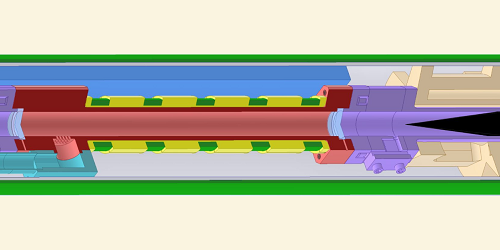Neutrino Mass in the Crosshairs
Neutrinos are at least 600,000 times lighter than the next-lightest elementary particle—the electron—but their exact mass remains unknown. Pinning down this mass would help refine both the standard model of particle physics and cosmology theories. Now the Project 8 Collaboration presents the first neutrino-mass constraint derived from a frequency-based technique [1, 2]. The team’s findings demonstrate the potential of such a technique for future neutrino-mass experiments.
For their measurements, the researchers studied the radioactive decay of tritium—a heavy hydrogen isotope. The decay of this isotope generates an electron and a neutrino, which share the energy released in the decay. By precisely determining the maximum total energy of the electron, scientists can infer the minimum total energy of the neutrino and, in turn, set an upper bound on its mass. Currently, the strongest such bound is 0.8 eV, which was reported by the Karlsruhe Tritium Neutrino (KATRIN) Collaboration last year (see Research News: Maximum Neutrino Mass Drops Again).
For that experiment, the KATRIN Collaboration measured the electron’s energy by directly detecting the particle. The Project 8 Collaboration instead used an indirect method. The team applied a uniform magnetic field to tritium as it decayed, causing the generated electron to move in a spiral path and emit radiation. The researchers then determined the electron’s energy by measuring the frequency of this radiation. Using a small-sized (centimeter-scale) version of the apparatus, the collaboration set an upper limit on the neutrino mass of roughly 150 eV. With a full-sized (meter-scale) version, the team expects to measure masses as low as 0.04 eV thanks to the precise electron-energy measurements that should be possible with this indirect method.
–Ryan Wilkinson
Ryan Wilkinson is a Corresponding Editor for Physics Magazine based in Durham, UK.
References
- A. Ashtari Esfahani et al. (Project 8 Collaboration), “Tritium beta spectrum measurement and neutrino mass limit from cyclotron radiation emission spectroscopy,” Phys. Rev. Lett. 131, 102502 (2023).
- A. Ashtari Esfahani et al. (Project 8 Collaboration), “Cyclotron radiation emission spectroscopy of electrons from tritium 𝛽 decay and 83mKr internal conversion,” Phys. Rev. C 109, 035503 (2024).




